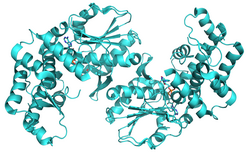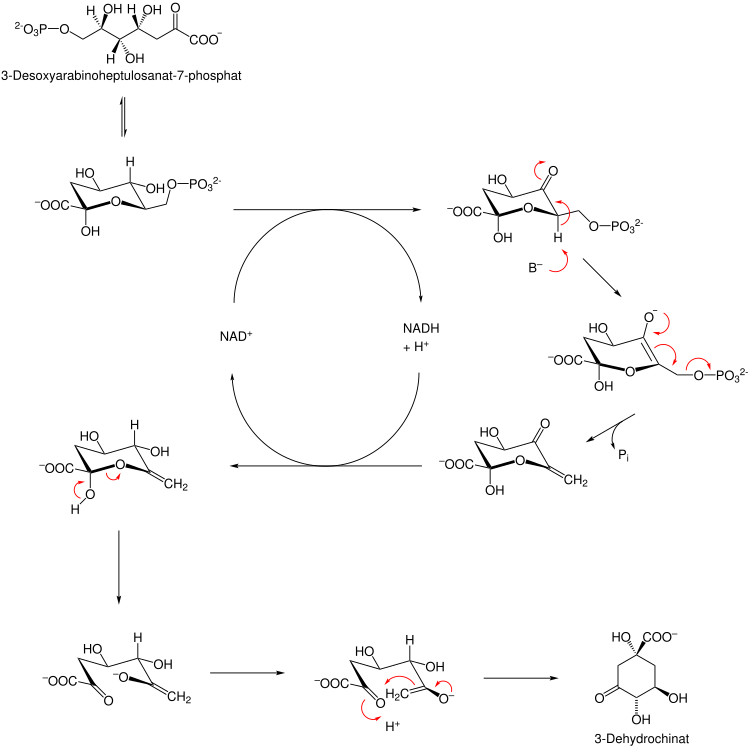3-dehydroquinate synthase
| 3-dehydroquinate synthase | ||
|---|---|---|

|
||
| Ribbon model of the 3-dehydroquinate synthase of Helicobacter pylori , according to PDB 3CLH | ||
| other names |
DHQ synthase |
|
| Mass / length primary structure | 362 amino acids , 38,881 Da | |
| Secondary to quaternary structure | Monomer, dimer, homodimer | |
| Cofactor | NAD + | |
| Identifier | ||
| Gene name (s) | aroB (E. coli) | |
| External IDs |
|
|
| Enzyme classification | ||
| EC, category | 4.2.3.4 , lyase | |
| Response type | Cyclization | |
| Substrate | 3-deoxyarabinoheptulosanate-7-phosphate | |
| Products | 3-dehydroquinate + P i | |
| Occurrence | ||
| Homology family | HOG000007970 | |
| Parent taxon | Bacteria , Eukaryota | |
| Orthologue (E. coli) | ||
| Entrez | 947927 | |
| UniProt | P07639 | |
| Refseq (protein) | NP_417848.1 | |
| PubMed search |
947927
|
|
3-Dehydroquinate synthase is an enzyme that mostly degenerates in bacteria , but also in eukaryotes and archaea . It catalyzes the second reaction step of the shikimic acid pathway . In this case, 3-Desoxyarabinoheptulosanat 7-phosphate to 3-dehydroquinate cyclized .
properties
In plants and microorganisms, the shikimic acid pathway enzymes are important for the production of the three aromatic amino acids . In 1970, SL Rotenberg and DB Sprinson, together with Turner et al . (1975) describe the exact reaction mechanism. The catalysis takes place in the enzyme with the help of multi-stage reaction mechanisms, u. a. alcohol oxidation, β-phosphate elimination, carbonyl reduction, ring opening and intramolecular aldol condensation . In some organisms, it forms a multi-enzyme complex , which as AROM complex is known. This complex is a pentafunctional polypeptide that can catalyze several steps in the shikimic acid pathway.
Reaction mechanism
use
The DHQ synthases from Xanthomonas oryzae and Helicobacter pylori are of particular importance for drug development . The enzyme from X. oryzae can be used as a potential antibiotic target , whereas in H. pylori the enzyme can act as a potential antimicrobial and antiparasitic agent and herbicide . In medicine, the enzyme from Mycobacterium tuberculosis is used as a target for the treatment of tuberculosis .
Individual evidence
- ↑ SL Rotenberg, DB Sprinson: Mechanism and stereochemistry of 5-dehydroquinate synthetase. In: Proceedings of the National Academy of Sciences . Volume 67, Number 4, December 1970, pp. 1669-1672, PMID 5275368 , PMC 283410 (free full text).
- ↑ L. Negron, ML Patchett, EJ Parker: Expression, Purification, and Characterization of Dehydroquinate Synthase from Pyrococcus furiosus. In: Enzyme research. Volume 2011, 2011, p. 134893, doi : 10.4061 / 2011/134893 , PMID 21603259 , PMC 3092513 (free full text).
- ↑ PT Ngo, S. Natarajan, H. Kim, HK Hung, JG Kim, BM Lee, YJ Ahn, LW Kang: Cloning, expression, crystallization and preliminary X-ray crystallographic analysis of 3-dehydroquinate synthase, Xoo1243, from Xanthomonas oryzae pv. oryzae. In: Acta crystallographica. Section F, Structural biology and crystallization communications. Volume 64, Pt 12 December 2008, pp. 1128–1131, doi : 10.1107 / S1744309108033575 , PMID 19052366 , PMC 2593707 (free full text).
- ↑ JS Liu, WC Cheng, HJ Wang, YC Chen, WC Wang: Structure-based inhibitor discovery of Helicobacter pylori dehydroquinate synthase. In: Biochemical and biophysical research communications. Volume 373, Number 1, August 2008, pp. 1-7, doi : 10.1016 / j.bbrc.2008.05.070 , PMID 18503755 .
- ↑ JD de Mendonça, F. Ely, MS Palma, J. Frazzon, LA Basso, DS Santos: Functional characterization by genetic complementation of aroB-encoded dehydroquinate synthase from Mycobacterium tuberculosis H37Rv and its heterologous expression and purification. In: Journal of bacteriology. Volume 189, Number 17, September 2007, pp. 6246-6252, doi : 10.1128 / JB.00425-07 , PMID 17586643 , PMC 1951933 (free full text).
